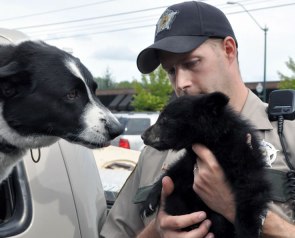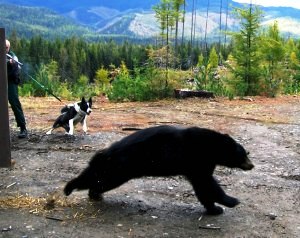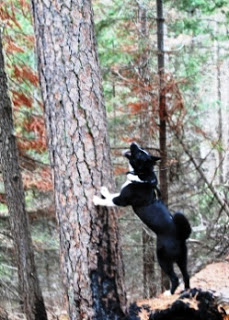Dogs
By Linda Cole
Humans have raised, bred and trained dogs to perform specific jobs for centuries. Canines have been used to guard flocks, homes and families, and to perform tricks to amuse us. There are even wildlife detection dogs. When we use the talents of dogs, it not only makes a job we have to do easier, it can also be the most effective way of taking care of a problem. A biologist working for the Washington State Department of Fish and Wildlife decided to combat a bear problem by utilizing one of the most efficient solutions to wandering bears – the Karelian Bear Dog. With the help of this brave dog breed, wildlife is being saved, and people are better protected.
The Karelian Bear Dog (KBD) is a rare and ancient breed native to Finland. They were bred to hunt elk, lynx, cougar, deer, moose, boar and bear. This fearless dog is ready to fiercely fight to the death to protect his owner, if necessary. This isn't a breed that likes to share his human with other dogs, and is dog aggressive. Nor is this a breed for someone who doesn't know how to properly train and control a powerful dog.
The Karelian Bear Dog is a natural hunter with a high prey drive, picking up both air and ground scents. A medium sized dog, standing 19 to 23 inches and weighing 40 to 65 pounds, the KBD is independent, extremely loyal, tough and an intelligent guard dog. The Karelian Bear Dog has no problem standing up to large prey, and he will not back down.
Anytime wildlife officials can find nonlethal methods to deal with problem predators getting too close to where humans live, it's a good thing for the environment, the animals and people. The KBD is capable of dealing with a Grizzly bear, but Washington State primary uses the dogs to control black bear. A pilot program in 2007 was set up with one dog, Mishka, and his handler, WDFW Officer Bruce Richards. It didn't take long for both of them to prove their worth by effectively dealing with complaints about problem bears.
The dogs are used to shepherd bear, an effective way of teaching predators to avoid humans. Three other dogs, Cash, Colter and Savute, have joined Mishka, and all four work to reduce human-bear encounters. After a bear has been captured, it's released in a remote area in a “hard release.” The dogs approach a bear still in a cage, barking constantly. If the bear charges the door of the cage, the dogs stand their ground. Upon release, wildlife officers shoot beanbags at the bear's behind, and fire blanks into the air to scare the predator as the dogs run after the animal as a warning to never return. The dogs are called back with whistles, otherwise they would continue chasing until the bear was treed.
The KBD’s talents go beyond helping to manage wildlife; they are also trained to locate evidence in poaching cases, find animal carcasses and spent bullet casings, and protect the wildlife officers from predators that may be drawn to a carcass. Shortly after Mishka and Richards began working as a team, Mishka was able to find enough evidence to prosecute a suspect accused of poaching elk. The poacher almost got off, because even after spending more than 600 hours searching for evidence, investigators couldn't find anything. Mishka was able to find it in 15 minutes.
Officer Richards, with the help of Mishka and the other dogs in the program, has a success rate of around 80 percent in hard releases, which are designed to reintroduce a natural fear of humans in the bear. Through the Karelian Bear Dog program, Richards and other wildlife officers have also initiated a public education program to help people living in bear country understand how to prevent bears from coming into populated areas.
Because of budget cuts, the enforcement program is funded completely with private money. The Karelian Bear Dog is a one-person dog, for the most part, and will protect the person he's bonded with. The dogs live with their handlers to make sure their bond is strong, because the wildlife officers depend on their dog to protect them in the field if a bear or cougar should attack. Since the program only gets money from private donations, the officers take care of the dog food and vet bills out of their own pockets.
There's no reason why humans and wildlife can't co-exist on the land. The Karelian Bear Dogs, and wildlife officials have found a way to deal with problem bears without using lethal force. The grizzly and black bear are an important part of the environment, keeping habitats healthy and strong. Using a dog born to stand up to a bear keeps the predator in his own backyard, and out of the backyards of residents.
Photos courtesy of Washington Department of Fish and Wildlife
Read more articles by Linda Cole
- Adventures In Aging: Living With A Senior Dog
"Bear" By Suzanne Alicie The past year has opened my eyes to the joys (?) of living with an aging/elderly dog. Bear is almost 11, and she is showing her age. As a fairly large dog, she is experiencing some arthritis and hip dysplasia symptoms. We’ve...
- How To Protect Your Pet From Wildlife Predators
By Linda Cole No matter where we live, we share the land with wildlife. Birds of prey, like hawks and eagles, can pose a danger to cats, small dogs, kittens and puppies. Depending on where you live, coyotes, mountain lions and bears may also be a threat....
- Wildlife Detection Dogs
By Linda Cole We are constantly finding new ways to use a dog's nose and their ability to control other animals in ways that are ecologically friendly and effective. Wildlife detection dogs are used at airports to keep runways free of pesky wild birds...
- Rare Dog Breeds From Around The World
By Linda Cole Rare dog breeds fascinate me. There's a mystic and awe that surrounds their existence. Rare breeds are not family dogs for the average owner, but rather have a specific purpose that aids us in certain tasks. They’re intelligent, independent...
- Sun Bear Facts And Information
The Sun Bear is the smallest of the bear family and lives in the forest of Southeast Asia. They only weigh 150 pounds in the Wild. Sun Bears are a mammal species and they can live up to 25 years in the wild. They are only 4-5 feet long and weigh 60-150...
Dogs
How the Karelian Bear Dog is Saving Wildlife
 |
| Mishka meets an abandoned bear cub |
Humans have raised, bred and trained dogs to perform specific jobs for centuries. Canines have been used to guard flocks, homes and families, and to perform tricks to amuse us. There are even wildlife detection dogs. When we use the talents of dogs, it not only makes a job we have to do easier, it can also be the most effective way of taking care of a problem. A biologist working for the Washington State Department of Fish and Wildlife decided to combat a bear problem by utilizing one of the most efficient solutions to wandering bears – the Karelian Bear Dog. With the help of this brave dog breed, wildlife is being saved, and people are better protected.
The Karelian Bear Dog (KBD) is a rare and ancient breed native to Finland. They were bred to hunt elk, lynx, cougar, deer, moose, boar and bear. This fearless dog is ready to fiercely fight to the death to protect his owner, if necessary. This isn't a breed that likes to share his human with other dogs, and is dog aggressive. Nor is this a breed for someone who doesn't know how to properly train and control a powerful dog.
 |
| Mishka is ready to go to work! |
The Karelian Bear Dog is a natural hunter with a high prey drive, picking up both air and ground scents. A medium sized dog, standing 19 to 23 inches and weighing 40 to 65 pounds, the KBD is independent, extremely loyal, tough and an intelligent guard dog. The Karelian Bear Dog has no problem standing up to large prey, and he will not back down.
Anytime wildlife officials can find nonlethal methods to deal with problem predators getting too close to where humans live, it's a good thing for the environment, the animals and people. The KBD is capable of dealing with a Grizzly bear, but Washington State primary uses the dogs to control black bear. A pilot program in 2007 was set up with one dog, Mishka, and his handler, WDFW Officer Bruce Richards. It didn't take long for both of them to prove their worth by effectively dealing with complaints about problem bears.
The dogs are used to shepherd bear, an effective way of teaching predators to avoid humans. Three other dogs, Cash, Colter and Savute, have joined Mishka, and all four work to reduce human-bear encounters. After a bear has been captured, it's released in a remote area in a “hard release.” The dogs approach a bear still in a cage, barking constantly. If the bear charges the door of the cage, the dogs stand their ground. Upon release, wildlife officers shoot beanbags at the bear's behind, and fire blanks into the air to scare the predator as the dogs run after the animal as a warning to never return. The dogs are called back with whistles, otherwise they would continue chasing until the bear was treed.
 |
| Mishka on a "hard release" |
Officer Richards, with the help of Mishka and the other dogs in the program, has a success rate of around 80 percent in hard releases, which are designed to reintroduce a natural fear of humans in the bear. Through the Karelian Bear Dog program, Richards and other wildlife officers have also initiated a public education program to help people living in bear country understand how to prevent bears from coming into populated areas.
 |
| Cash trees a bear |
There's no reason why humans and wildlife can't co-exist on the land. The Karelian Bear Dogs, and wildlife officials have found a way to deal with problem bears without using lethal force. The grizzly and black bear are an important part of the environment, keeping habitats healthy and strong. Using a dog born to stand up to a bear keeps the predator in his own backyard, and out of the backyards of residents.
Photos courtesy of Washington Department of Fish and Wildlife
Read more articles by Linda Cole
- Adventures In Aging: Living With A Senior Dog
"Bear" By Suzanne Alicie The past year has opened my eyes to the joys (?) of living with an aging/elderly dog. Bear is almost 11, and she is showing her age. As a fairly large dog, she is experiencing some arthritis and hip dysplasia symptoms. We’ve...
- How To Protect Your Pet From Wildlife Predators
By Linda Cole No matter where we live, we share the land with wildlife. Birds of prey, like hawks and eagles, can pose a danger to cats, small dogs, kittens and puppies. Depending on where you live, coyotes, mountain lions and bears may also be a threat....
- Wildlife Detection Dogs
By Linda Cole We are constantly finding new ways to use a dog's nose and their ability to control other animals in ways that are ecologically friendly and effective. Wildlife detection dogs are used at airports to keep runways free of pesky wild birds...
- Rare Dog Breeds From Around The World
By Linda Cole Rare dog breeds fascinate me. There's a mystic and awe that surrounds their existence. Rare breeds are not family dogs for the average owner, but rather have a specific purpose that aids us in certain tasks. They’re intelligent, independent...
- Sun Bear Facts And Information
The Sun Bear is the smallest of the bear family and lives in the forest of Southeast Asia. They only weigh 150 pounds in the Wild. Sun Bears are a mammal species and they can live up to 25 years in the wild. They are only 4-5 feet long and weigh 60-150...
